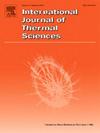A novel model for the removal and capture of inclusions in electroslag remelting process
IF 4.9
2区 工程技术
Q1 ENGINEERING, MECHANICAL
International Journal of Thermal Sciences
Pub Date : 2025-06-18
DOI:10.1016/j.ijthermalsci.2025.110090
引用次数: 0
Abstract
The cleanliness of steel is a critical factor influencing its corrosion resistance and mechanical properties. Electroslag remelting (ESR) technology has demonstrated excellent performance in removing inclusions from electroslag ingots. Typically, four primary pathways exist to remove and capture inherited inclusions from the electrode in the ESR process. Current numerical simulation research typically focuses on modeling two or three of these pathways. This study, presents a highly accurate model that integrates the electromagnetic field with the flow field and heat transfer throughout the entire process of inclusion movement, removal and capture processes in ESR. To validate the model's accuracy, a 2 t industrial-scale ESR furnace was utilized to prepare hot work tool steel H13. The model's ability to predict the distribution of inherited inclusions from the electrode was confirmed by comparing the metal droplet size in the residual electrode and the distribution of inclusions in the electroslag ingot as measured in industrial production. The results reveal that the proportion of inclusions exuded from the liquid metal film decreased as the size of inclusions increased from 5 to 20 μm. The proportion of inclusions that escape from the droplets and float up from the metal pool exhibited a significant increase. Notably, the escape of inclusions from metal droplets accounts for a substantial proportion (exceeding ten percent), and this stage is a crucial factor that must be considered in industrial-scale models.
电渣重熔过程中夹杂物去除捕获的新模型
钢的清洁度是影响其耐蚀性和力学性能的关键因素。电渣重熔技术在去除电渣钢锭中的夹杂物方面表现出优异的性能。通常,在ESR过程中,存在四种主要途径来去除和捕获电极上的遗传内含物。目前的数值模拟研究通常侧重于对其中的两种或三种路径进行建模。本研究提出了一个将电磁场、流场和传热整合到ESR中包裹体移动、去除和捕获全过程的高精度模型。为了验证模型的准确性,利用2 t工业规模的ESR炉制备了热加工工具钢H13。通过比较残余电极中的金属液滴尺寸和工业生产中测量的电渣锭中夹杂物的分布,证实了该模型预测电极遗传夹杂物分布的能力。结果表明:随着夹杂物尺寸从5 μm增大到20 μm,金属液膜中夹杂物的析出比例减小;夹杂物从液滴中逸出并从金属池中向上漂浮的比例显著增加。值得注意的是,金属液滴中夹杂物的逸出占了相当大的比例(超过10%),这一阶段是工业规模模型中必须考虑的关键因素。
本文章由计算机程序翻译,如有差异,请以英文原文为准。
求助全文
约1分钟内获得全文
求助全文
来源期刊

International Journal of Thermal Sciences
工程技术-工程:机械
CiteScore
8.10
自引率
11.10%
发文量
531
审稿时长
55 days
期刊介绍:
The International Journal of Thermal Sciences is a journal devoted to the publication of fundamental studies on the physics of transfer processes in general, with an emphasis on thermal aspects and also applied research on various processes, energy systems and the environment. Articles are published in English and French, and are subject to peer review.
The fundamental subjects considered within the scope of the journal are:
* Heat and relevant mass transfer at all scales (nano, micro and macro) and in all types of material (heterogeneous, composites, biological,...) and fluid flow
* Forced, natural or mixed convection in reactive or non-reactive media
* Single or multi–phase fluid flow with or without phase change
* Near–and far–field radiative heat transfer
* Combined modes of heat transfer in complex systems (for example, plasmas, biological, geological,...)
* Multiscale modelling
The applied research topics include:
* Heat exchangers, heat pipes, cooling processes
* Transport phenomena taking place in industrial processes (chemical, food and agricultural, metallurgical, space and aeronautical, automobile industries)
* Nano–and micro–technology for energy, space, biosystems and devices
* Heat transport analysis in advanced systems
* Impact of energy–related processes on environment, and emerging energy systems
The study of thermophysical properties of materials and fluids, thermal measurement techniques, inverse methods, and the developments of experimental methods are within the scope of the International Journal of Thermal Sciences which also covers the modelling, and numerical methods applied to thermal transfer.
 求助内容:
求助内容: 应助结果提醒方式:
应助结果提醒方式:


